Toilet and bathroom belong to the category of rooms with high humidity, requiring high-quality and constant air exchange. The specificity of their planning and operation requires an unhindered supply of fresh air, removal of pollution, dampness and unpleasant odors. It is not difficult to achieve this if you know the current building and sanitary standards, have at your disposal enough funds and a set of standard household tools. Self-arrangement of ventilation in the bathroom and toilet will help save on the services of hired craftsmen.
The need for ventilation in the bathroom and toilet

In panel multi-storey buildings, bathrooms do not have windows, which significantly complicates their ventilation. The existing holes in the walls do not always help to solve the problem of air exchange. In most cases, it is necessary to lay channels and install exhaust technology.
Well thought-out ventilation in the bathroom and in the toilet prevents the occurrence of such troubles:
- Excessive dampness. In such conditions, it is difficult to breathe, as there is not enough oxygen. Even a short stay in a damp room can lead to headaches.
- The development of mold and mildew. These microorganisms multiply rapidly in areas where condensation forms. Disputes are the cause of allergies, diseases of the digestive and respiratory systems.
- Bad smell. He is almost always present in the toilet. The bathroom can come from dirty laundry in the container and from the washing machine. Over time, odors can permeate all surfaces of the premises, you can get rid of them only together with the decoration and interior items.
- Damage to furniture, appliances and accessories. Moisture causes destruction of wood and wood-based materials. Dampness causes metal accessories, valves and parts of household appliances to rust. The service life of a wooden house is reduced due to rotting of the supporting structures.
- Damage to the finish. The reflective layer on the mirrors peels off, the tile is covered with a dense lime coating, the seams between the tiles turn black.
If you put a fan in the bathroom and toilet, such troubles can remain only a theory. But this must be done correctly and competently, taking into account the engineering features of the house, apartment and a single room.
Basic standards and requirements
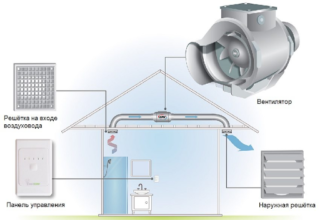
Forced extractor hoods in the bathroom and toilet must comply with safety measures and sanitary standards.
First of all, you need to determine what kind of air inflow and outflow should be in the room. For bathrooms, the air exchange rate is set equal to 10. Knowing the volume of the room, it is easy to calculate the capacity of the required equipment. For ventilation in a bathroom with a size of 2 × 3 m and a ceiling height of 2.5 m (total 15 m³), a device with a capacity of at least 150 m³ / h is required.
In addition, the ventilation for the toilet and bathroom must be electrically safe. Pay attention to the labeling of the devices. Products with a degree of protection IP25 and higher are suitable for wet rooms.
The next criterion is the level of noise produced.For medical reasons, ventilation in the toilet cannot produce sounds louder than 25 dB. The louder noise is harmful to the hearing organs and can cause headaches and high blood pressure.
Another requirement is the tightness of the system. Through an open channel from the ventilation shaft, harmful vapors, insects, pathogens can penetrate into the bathroom. The grid solves the issue only partially. The valve is more effective protection.
Types of ventilation systems
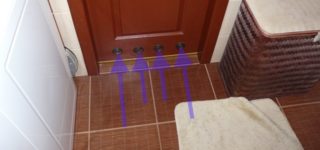
A shared bathroom requires good ventilation, as it concentrates vapors from hot water and odors associated with using the toilet. Even for a toilet of a small area and volume, it will be necessary to ensure air exchange at the level of 25-30 m³ / h. The choice of design to ensure this process should be approached taking into account the peculiarities of housing planning. There are several types of ventilation systems for toilets and bathrooms.
Natural
It is usually installed in multi-storey buildings and covers all apartments connected to one common shaft. In addition to the shaft, the structure includes a common collector in the attic. Designed to collect polluted air and bring it out into the street. The apartments have ducts and openings connecting rooms with vertical exhaust openings. Air supply is provided through cracks, keyholes, ajar windows and specially made openings.
The principle of operation of natural ventilation is based on the movement of masses between areas of high and low pressures. This effect is observed in apartment buildings, when the difference in these indicators is several tens of mm. r.s. A sufficiently strong draft arises, which contributes to the fact that the mine literally sucks in polluted air from the apartments. However, such designs have one significant drawback. It consists in the fact that in quiet cloudy weather, the thrust can completely disappear and even change direction. In such cases, odors flow from apartment to apartment.
Forced
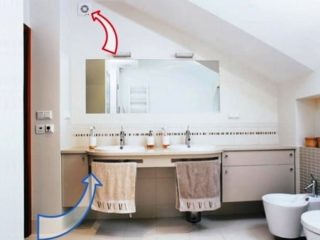
Such designs imply the creation of a two-way design, where through one air is supplied to the room, and through the other it is removed.
Forced ventilation is divided into the following categories:
- Supply air. This implies the installation of a blower at the bottom of the building. Filters, heaters and coolers can be used to adapt the atmosphere to the room temperature.
- Exhaust. In these designs, the fans are mounted in the collector, and the removal of contaminants is carried out by mechanically creating an area of reduced pressure in the upper part of the building.
- Combined. The fans are top and bottom mounted, which ensures powerful and stable air circulation throughout all levels of the house.
The choice of the system is determined by the layout of the building and the ability of construction organizations to carry out installation work.
Fan classification
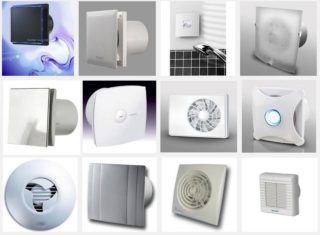
To choose the right fan, you need to study the layout and location of the shaft and ducts, as well as their configuration. You may need to make new holes and install additional communications. It must be remembered that high-quality air circulation is possible only if there is an inflow and outflow. If one condition is missing, the second becomes useless.
To make a hood in a bathroom or toilet, you can use these types of fans:
- Axial wall mounted. The products represent a propeller fixed to the shaft of an electric motor. The body of the device is round, which makes it easy to adapt it to channels of the corresponding cross-section.The air is directed along the axis of the motor, thereby achieving a high efficiency of the device.
- Radial. The principle of operation is based on centrifugal force, which is created by a rotating drum located across the channel. There are fixed and adjustable blade models. The spinning drum throws air to the sides, where it is compacted in the housing and fed into the channel. A vacuum is created, which contributes to the suction of the masses from the outside.
- Duct. They are tie-ins in communications, inside which fans of axial or centrifugal type are installed. Designed to increase traction in the channel with its long length or after bends.
- Rooftop. The products are used in mechanical systems of the exhaust or combined type. They are installed at the necks of vertical shafts to suck in polluted air and then release it into the collector, from where it is discharged to the street.
In one entrance or even an apartment, you can install devices of different designs, if necessary to improve the efficiency of the system.
Equipment selection criteria

The widest selection of fans with a wide variety of technical characteristics is on sale.
When purchasing equipment, you should pay attention to the following criteria:
- Power. It must correspond to the volume of the room, provide an air exchange rate of 10-12.
- Safety. Instruments with splash-proof enclosures with sealed sealed contacts should be taken. Products with an IP44 rating are considered completely safe.
- Diameter of the nozzle. It must be matched to the channel section. Construction standards are 100, 125, 150 mm.
- The level of the generated noise. For radial fans, it is slightly lower, but also larger in size.
- Service capability. The easiest way is to access the blades of axial-type instruments. It is difficult to get to the drum, in some models it is impossible. Such a situation can lead to the fact that the blades lose their aerodynamic qualities from dirt, and the motor operating with overload will burn out.
- Valve presence. When the fan rotates and there is natural draft, it opens, letting dirt through the case. The rest of the time it is closed, preventing the waste masses from entering the bathroom from the mine.
Given these nuances, it will be easy to select and install the model that best matches the ratio of performance criteria, price and quality.
The subtleties of installing ventilation in the bathroom and toilet
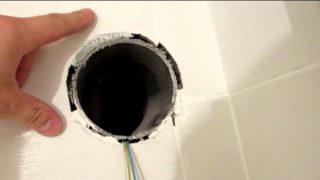
Installation of a ventilation system in the bathroom and toilet is not particularly difficult if a vertical shaft passes nearby. It is enough to make a hole in the wall and insert an axial fan into it. It is more difficult if there is no such channel. In this case, you will have to lay an air duct from plastic pipes.
When performing this activity, you should use the following recommendations:
- Make a duct from rectangular pipes that look better and are easier to install.
- Use the space above the false ceiling to mask communications.
- Before connecting the sections, lubricate the joints with silicone in order to achieve the tightness of the pipeline.
- If the location of the room is such that it is necessary to conduct a highway with turns, use rounded elbows, which almost do not weaken traction.
- Use shaped fasteners during assembly, which will speed up and simplify the installation process.
After completing the work, it is advisable to check the performance of the system, paying attention to the joints through which dirty air can leak into the premises.
Operating rules
In order for the ventilation to work stably and efficiently, it must be serviced periodically. Prevention does not take much time and effort. Depending on the intensity of use, the structure should be disassembled every 6-12 months, the mosquito net, channels and blades of the device should be cleaned, and the motor shaft should be lubricated.This will provide high-quality air exchange required for comfort in the apartment.








